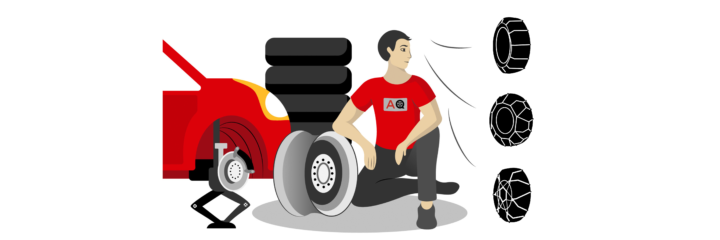If you live in a snowy climate, you’ve probably experienced some of the major downsides to owning a car in winter. Maybe on an icy morning, you’ve gotten stuck in your own driveway, maybe you’ve even skidded across a snowy road and have gotten into an accident. Not everyone has the option to bunker down and stay in whenever there’s a hint of snow in the weather forecast, so choosing the best tire chains for snow can help avoid dangerous situations and expensive towing bills.
In this guide, we’ll walk you through the basic types of tire chains and give you information to help you to choose what style is right for you. If you’re new to snow chains, you can also find some basic later in this guide, but always read the instructions for your specific set.
- What You Need to Know About Tire Chains for Snow
- Top 10 Best Tire Chains for Snow 2025
- 1. Best Overall Tire Chains: Security Chain Company ZT741 Super Z LT
- 2. Best Premium Tire Chains: Peerless 0232805 Auto-Trac Light
- 3. Easiest to Install Tire Chains: Security Chain Company SZ143 Super Z6
- 4. Simplest Tire Chains: KONIG CB-12 090 Snow chains
- 5. Smallest Radial Chains: Glacier 1046 Passenger Cable Tire Chain
- 6. Best Budget Tire Chains: Security Chain Company SC1032 Radial Chain Cable Traction Tire Chain
- 7. Best for Deeper Snow: Peerless 0155505 Auto-Trac Tire Traction Chain
- 8. Great for Wet Snow: Security Chain Company SZ343 Shur Grip Super Z Passenger Car Tire Traction Chains
- 9. Best Snow Sock: ISSE C60070 Classic Issue Snow Socks
- 10. Good for the Occasional Emergency: Zip Grip Go Cleated Tire Traction Device
- Your Complete Guide to Tire Chains for Snow
- Drive Safely With the Best Tire Chains for Snow
What You Need to Know About Tire Chains for Snow
Before we check out the best products available, let’s dive into the most vital info to know before you make a decision.
How to Choose the Right Size
To order snow chains that will fit correctly, you need to know your tire size. Each tire will have information about its width, height, and diameter printed on it. Once you have that information, you can figure out your ideal snow chain size. The make and model of your vehicle may also affect which option will work for you, so check your vehicle manual.
SAE Class
Some tires may require you to take into account the amount of clearance available within the wheel well. If your vehicle has special requirements due to limited space, you’ll be able to find that information in your owner’s manual. The SAE (Society of Automotive Engineers) size class for chains fall into one of three categories: S, U, and W. S has the least amount of clearance between the tire tread and wheel well, W has the greatest and U is in the middle. Most of the options featured in our guide fall under an S classification, but some vehicles will have trouble even fitting that.
Things to Know About Tire Chain Varieties
There are plenty of options for snow chains on the market currently, from simple workhorses, lighter duty assistants, and high-tech options with premium features. Most chains, however, fall into several basic categories that describe how they work on your car.
Adjustment Features
Snow chains come in one of three levels of adjustment: automatic, assisted, or manual.
- Automatic chains are a premium variety that will adjust themselves to conditions as you drive. Though this is convenient, you still will need to check on your chains regularly to make sure they are correctly configured.
- Chains with assisted adjustment have devices that help adjust tension while you’re installing the chains but don’t make any on-the-road adjustments.
- Manual chains are chains your grandparents would recognize. They take some adjustments during installation to ensure a correct fit and tend to be more affordable than assisted or automatic adjustment chains.
Configurations
The two most common styles of snow chains on the market are Z Chains and Radial Chains.
Z Chains create a zigzag, or Z pattern across your tire tread. They are easy to install and are typically the best choice for cars with antilock brake systems or all-wheel drive. They usually meet the SAE’s S class qualifications, giving them a low profile for less roomy wheel wells.
Radial Chains are lightweight, long-lasting, and high performance, but not as ideal for cars with electrically monitored systems. Radial Chains are configured with horizontal lines across the tire tread. Some chains will also feature a diamond pattern that can give better lateral traction on icy roads but are a little harder to install.
Chain vs Cable vs Socks
In recent years tire cables have gained popularity and are competing with classic chain link styles options. Tire cables are usually made out of metal coils that surround a cable made of metal or a polyurethane material, whereas traditional tires chains are metal chain links.
Typically, cables are smaller and lighter, and chains are a bit more durable and provide deeper traction. Of course, this varies by model. Chains pose more of a risk to your vehicle if improperly installed.
Snow Socks are a relatively new option on the market. They are a low cost alternative to chains and cables that are less likely to pop off during use, but are only effective in certain weather conditions and are much less likely to last you multiple winters.
We cover all these types on our list, so you’ll be sure to find your ideal match.
Which Tire Chain Is Best for You?
When choosing which chains are best for you, you’ll have to consider a number of factors. For our list, we focused on several main points.
Overall Performance
When your family’s safety is on the line, reliable performance over multiple uses is the most important factor.
Ease of Installation
Since your snow chains will likely be removed and installed multiple times over the course of the winter, having a set that you can easily and quickly install is essential.
Availability
Being able to get the tires you need in the size that works for your vehicle is a priority. All of the top choices on our list are available in a range of sizes and from more established brands.
Now that we’ve covered what to look for in tire chains for snow, let’s check out the best options on the market today.
Top 10 Best Tire Chains for Snow 2025
1. Best Overall Tire Chains: Security Chain Company ZT741 Super Z LT
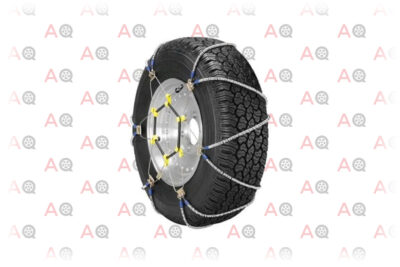
Editor’s Rating:
Quick Facts:
- SAE Class: S
- Type: Cable
Breaking with tradition, these “chains” are actually durable cables. Their Z configuration makes them perfect for vehicles with anti-lock brakes or other digital monitoring systems. With a comprehensive size chart, Security Chain helps you ensure you find the best tire chain to fit your car. These chains have an assisted adjustment feature in the form of a rubber tensioner to help with installation.
The low profile of these chains meets the SAE’s S size classification, so even the narrowest wheel well can accommodate these chains. The Z configured chains are relatively easy to install, which makes it quicker to swap on and off from day to day. The kit even includes a pair of waterproof gloves for consumers to wear during the installation process, which is a thoughtful touch.
The only issue that can crop up with these chains is the rubber tensioner. Since the chains must have the tensioner attached to function, if it gets damaged, the chains are unusable, though replacements are available from some retailers. Under strain, this tensioner can occasionally pop off. Fortunately, due to the small and light nature of these cables, it’s very unlikely to do any damage to your vehicle if it does. It’s just an inconvenience.
Overall, these are a good value for the price, and one of the most reliable no-fuss options for snow chains. They’re one of the best tire chains for snow on the market currently and will suit most drivers’ needs.
Pros
- Will fit most modern vehicles
- Easy installation and tension adjustment
- Reliable and durable
- Provide even traction
Cons
- Not ideal for heavier trucks
- Possibility for rubber tensioner to malfunction
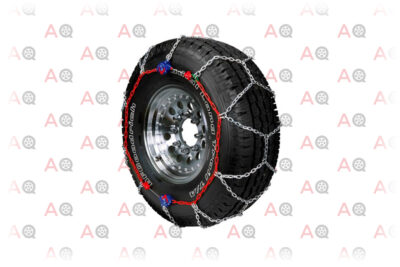
Editor’s Rating:
Quick Facts:
- SAE Class: S
- Type: Chain
Featuring a diamond pattern chain configuration, these tire chains boast excellent tractioning. The chains are extremely light thanks to a magnesium-steel alloy which makes the links strong and hard-wearing while reducing added weight and keeping the chain smaller and narrower. This set meets the SAE’s S classification for fitting in tighter spaces and works with light trucks and SUVs. They are higher-priced than many others on this list, but for those who frequently deal with snow, they can be worth it. If you’re on a tighter budget, take a look at Security Chain Company SC1032 instead.
Featuring an automatic tensioner, these chains are convenient to install and will continue to adjust their fit throughout the ride. However, this tensioning system is made from polymer, so it is considerably weaker than the chains and more prone to failure. This can decrease the overall durability of what is otherwise a stellar product. This risk increases if you go above the recommended 30 miles per hour while using the chains.
The manufacturer’s size chart can cause some confusion and using the incorrect size greatly increases your odds of a malfunction, so take extra care when choosing your size online.
Most users will have a positive experience with these chains, and they are the best option for especially deep snow, so if you live in a climate that frequently gets feet instead of inches of snow in one night, they might be the best choice for you.
Pros
- Lightweight and durable magnesium steel alloy
- Convenient self-tensioning features
- Smooth traction in the deepest of snowfall
Cons
- Polymer tensioner is a weak point in the construction
- Confusing manufacturer’s size chart
- Expensive
3. Easiest to Install Tire Chains: Security Chain Company SZ143 Super Z6
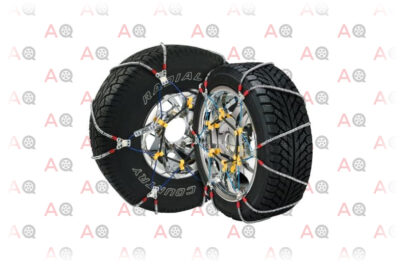
Editor’s Rating:
Quick Facts:
- SAE Class: S
- Type: Cable
Another cable option, these have a few significant differences from our top choice. Though they look more complicated, with a full auto-tensioning system, they are one of the easiest sets to install. It’s perfect if you’re installing on the go since they don’t require you to drive on to them to install or tighten. They will also adjust their tension as you drive, causing fewer stops and starts for you.
Even smaller than our top choice, they will fit in extremely narrow spaces. This is perfect if you live in an area that requires you to have snow chains, but none usually fit your vehicle, even a standard S class chain. The Z configuration will give you better traction without affecting the performance of your anti-lock brake systems as well.
With more features, there is always a greater risk of malfunction and even user error. These chains seem to shine best in situations where you’re driving a short distance in light ice and slush. Long-term use in heavier snow increases the odds of your tensioning system coming loose or breaking.
Pros
- Easy to install on the go
- Will fit tighter spaces than the typical S class chains
- Self-tensions as you drive
Cons
- Not as ideal for heavy snow or long road trips
- The tensioning system has a higher rate of failure
4. Simplest Tire Chains: KONIG CB-12 090 Snow chains
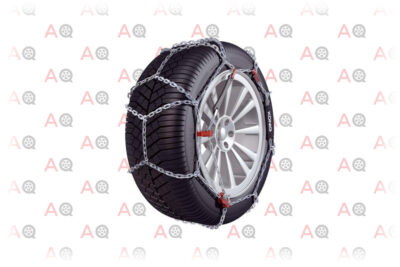
Editor’s Rating:
Quick Facts:
- SAE Class: Info Not Provided by Manufacturer
- Type: Chain
Made from a light and durable manganese nickel alloy steel, these chains are pared down and no-frills. Since they are a manual adjustment model, they take a little more time and hassle to install (even more if you have to untangle the chain first– not uncommon for this set) and ensure you have it properly tightened. However, fewer moving pieces give you sturdier construction with few possible breaking points.
Combining a diamond-shaped chain configuration with D-links, this set provides superior traction and a smoother ride in slippery conditions. These are especially effective at helping your vehicle get uphill in icy situations. Anticipating the kind of weather you’ll be using them in, the manufacturer’s instructions come laminated, which is very convenient.
If you’re able to put forth a little extra time and effort to use these manual chains, you’ll get a reliable and rugged product at a lower price than many automatic and assisted adjustment options. Just remember to give yourself a trial run (or two) to feel confident adjusting them before trying to do it on the side of the road in the dark.
Pros
- Reliable and sturdy construction
- Excellent in icy conditions
- Gives a smooth ride
Cons
- Takes more time and practice to install
- May need to be tensioned again after some driving
5. Smallest Radial Chains: Glacier 1046 Passenger Cable Tire Chain
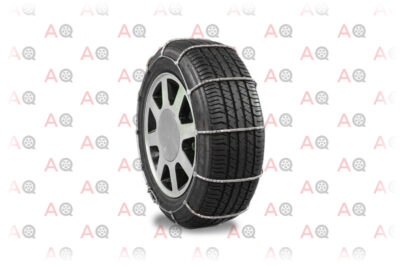
Editor’s Rating:
Quick Facts:
- SAE Class: S
- Type: Cable
Unlike most snow cables, this set by Glacier uses steel rollers rather than coils to offer extra grip while driving. The radial style is both a major asset and a downside: it offers evenly distributed traction across your wheel for a safe and smooth ride, but it also won’t work with many vehicles. Check your owner’s manual, but if you’re equipped with an anti-lock brake system, you likely won’t be able to use these. However, they do fit snugly on vehicles that often can’t accept snow chains like certain Subaru models.
On the plus side, these perform well in a variety of weather and road conditions. If you live in a rural area, these can even offer extra security on gravel roads. They’re quick and easy to install, but are more likely to break if used on dry roads at higher speeds. For digging into ice on asphalt though, they are one of the top performers.
These show no signs of rust or corrosion after multiple uses on icy roads with salt melt, making them a good candidate for areas that get frequent snowstorms throughout the season. Many users do find that they need to buy a tensioner to keep them appropriately fitted during use; the set does not come with one and must be manually adjusted.
Pros
- Strong and rust-resistant steel construction
- Good fit for cars that can’t usually accept chains
- Improved traction on both gravel and asphalt
- Even radial traction
Cons
- Will not work with many modern vehicles with ABS systems
- May need to buy separate tensioner to maintain fit
- Higher likelihood of breakage on dry roads
6. Best Budget Tire Chains: Security Chain Company SC1032 Radial Chain Cable Traction Tire Chain

Editor’s Rating:
Quick Facts:
- SAE Class: S
- Type: Cable
Like most radial chains, these won’t be ideal for most cars with anti-lock brakes. However, these fit a variety of vehicle sizes and styles and improve traction even on gravel roads. The steel coil design is tough and can make the difference between getting stuck and getting home when there are several inches of snow on the ground.
These are particularly useful for getting out of wet and slushy situations, more than for long drives in ice. If you’re looking for an option that will get you out of a difficult driveway and onto a nearby plowed road, they are a good option. For long term use, they can cause inconvenience by needing more frequent manual adjustments than their competitors. This style also cannot have a tensioner attached to help mitigate this problem.
While they aren’t as reliable as some of our other cable options, they may fit the bill if you live in an area that gets infrequent storms, and you won’t be driving long distances on unplowed roads with them. They also make a good back-up to have on hand for occasional use. They come in a handy plastic storage case which helps keep them from getting tangled while in your trunk or garage.
Pros
- A more affordable option
- Durable, anti-rust steel construction
- Works well on gravel and in slushy conditions
Cons
- Needs more frequent manual tensioning
- Not as effective over long distances
7. Best for Deeper Snow: Peerless 0155505 Auto-Trac Tire Traction Chain
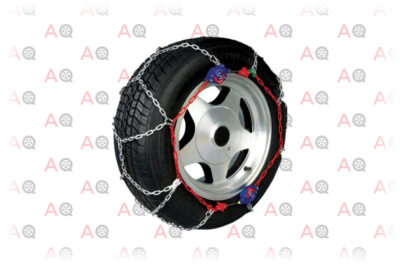
Editor’s Rating:
Quick Facts:
- SAE Class: S
- Type: Chain
While not quite as impressive as the other Peerless option on our list, the 0155505 model still deserves recognition. It has a lot of the same features we love from the 0232805. Like the other model, this features tough magnesium steel alloy chain links in a diamond pattern that works well for digging into deeper snow. They also meet the SAE’s S size classification, fitting many vehicle models. These chains are also convenient, offering automatic tensioning so you don’t need to stop and tighten once you install them, even as you drive.
So why choose these over the brand’s 0232805 model? This set is particularly easy to install and runs a little bit cheaper than the other model. While they are not quite as durable, with some of the hooks showing some bending after several uses– some sets came unhooked during use or were a bit more difficult to remove, they could be an option if you don’t need something as heavy-duty and don’t plan on using them over long distances.
Unlike Peerless 0232805, these chains are more suited to smaller passenger vehicles, rather than made to accommodate small trucks and SUVs. So, if the other model is not available or you don’t need something quite as beefy and want to save a few dollars, this model might be the better choice for your needs. Keep in mind that like our other Peerless choice, the size chart can be a tad confusing. If you’re in doubt, you can contact Peerless’s customer service to be certain.
Pros
- Quick and easy installation
- Diamond chains configuration work well in deeper snow
- Less expensive than other Peerless options
Cons
- Not suitable for SUVs and small trucks
- Not as durable for long-term use
- Confusing size chart
8. Great for Wet Snow: Security Chain Company SZ343 Shur Grip Super Z Passenger Car Tire Traction Chains
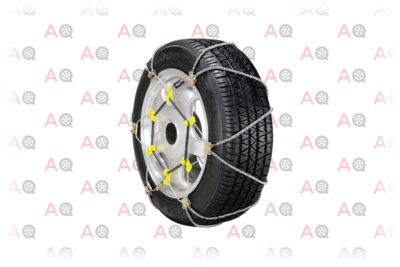
Editor’s Rating:
Quick Facts:
- SAE Class: S
- Type: Cable
Coming in at a moderate price point, Security Chain’s Shur Grip cables are a great option if you’re new to the snowbound life. They are one of the simplest for installing by yourself since you don’t have to move the vehicle to get them on, and they come with a rubber tensioner to save you from having to make adjustments during use. For newer snow chain users, this can offer major peace of mind while improving your vehicle’s winter performance.
These steel coil cables are especially useful in soft, wet snow, where winter tires aren’t as effective. While not quite hearty enough to get you through very deep snowdrifts, it can help you get through a few inches laying on the road or in your driveway. They handle reasonably well on inclines as well, where a standard all-season or even winter tire may struggle.
The main issue that has come up with these chains is that some sets have been sent out with manufacturing defects that make them difficult or impossible to install. It’s especially important with these (or any chains) to remove them from the packaging and do a test run of installing them as soon as they arrive. You wouldn’t want to discover that they are unusable when you are stuck on the side of the road in a snowstorm.
Like most chains that feature a rubber tensioning device, there is always a risk of that popping off or breaking under stress and the chains are unable to function without that piece attached.
Pros
- Easy and quick to install
- Self-tensioning feature simplifies the process
- Especially good at handling in wet snow
Cons
- Some sets have had manufacturing defects
- Risk of losing or breaking essential rubber tensioner
9. Best Snow Sock: ISSE C60070 Classic Issue Snow Socks

Editor’s Rating:
Quick Facts:
- SAE Class: N/A
- Type: Socks
A peculiar and unexpected sight on the road, snow socks are textile tire covers that combine a woven fabric cover with an elastomer strap to hold it in place. Fans swear by them for a simple solution that won’t damage your vehicle or have any clearance issues in small wheel wells. They’re also quieter to run than traditional chains.
These snow socks actually do a couple of things quite well. They go on quickly and they perform well in icy conditions and situations where there are a few inches (the sweet spot seems to be around 1-3) of snow covering the ground. They are particularly effective for vehicles with rear-wheel drive and getting your vehicle out of an unplowed area.
There are also several areas where they don’t perform well at all. If you’re trying to drive through deeper snow, these don’t offer much traction. Wet, slushy conditions can render these ineffective as well, soaking through the fabric and weighing them down. That makes the socks more prone to slipping during use. If you are driving through areas that have patches of clear, dry road between snow and ice, the dry spots will cause wear on the socks. This can cause major fraying and will eventually wear completely through and shred the material.
These are a good option if you have certain specific needs. If you just want an inexpensive device to use in case of emergency, these will help get you unstuck from an icy patch. If you also live in a climate that stays very cold all day long, not thawing and getting slushy, these can be helpful for navigating driveways and parking lots that haven’t been plowed. For most other use-cases, though, these won’t fit the bill or be useful long-term.
Pros
- Handles ice and lighter snowfall well
- Easy and fast to install
- Won’t damage vehicle
Cons
- Not suited to a variety of road conditions
- Can easily become too wet to be effective or fray
- Does not provide enough traction in deep snow
10. Good for the Occasional Emergency: Zip Grip Go Cleated Tire Traction Device
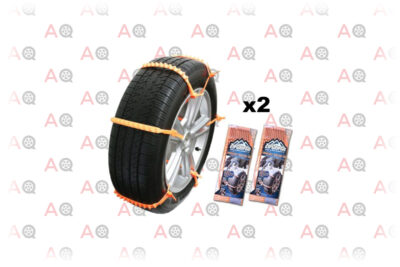
Editor’s Rating:
Quick Facts:
- SAE Class: N/A
- Type: Temporary Zip Ties
Unlike other snow chains, these ratchet onto your wheels like cable ties. Because of that, they can accommodate most wheel sizes and vehicle types. They are simple and intuitive to install, no need to do a test run in advance. Plus, they take up very little space in the trunk of your car.
Designed to help get your car free from a patch of unplowed ice or snow, they are not rated for any sort of durability. In fact, they aren’t recommended for any sort of distance driving.
They do what they’re designed for decently, providing that extra traction that can mean the difference between being stuck in a parking spot and making it safely onto the plowed road. Any amount of driving beyond that is likely to break these tie-on cables. As soon as you’ve moved out of the snowy or icy section, simply cut off the ties and be on your way.
These could be a good option for someone who doesn’t live in an area where heavy snow and ice are common but wants to be prepared just in case. If you make a yearly trip to visit relatives in a colder climate, these are an easy and less expensive option to have just in case bad weather strikes on the road.
While the initial cost of these is lower than your average set of tire chains, bear in mind that they are sold in packs of 10 or 20 and that you might need to use all of them to secure your tires. Since they aren’t reusable, a 10 pack will likely only cover two of your tires in one inclement weather situation.
Pros
- No practice installing needed
- Small and inexpensive
- Good for emergencies
Cons
- Only rated for extremely short-term use
- Not reusable
Your Complete Guide to Tire Chains for Snow
Getting the right tire chains for now can have a major impact on your safety. To help you feel confident in your choice, we’ve answered some additional questions below.
When Do I Need Tire Chains for Snow?
You don’t need to leave your tire chains on your wheels all the time. Instead, you’ll only want to use them when there is at least one inch of snow on the roads. Since roads are often plowed relatively quickly, this means that you’ll usually use tire chains right after a snowstorm.
If you live in an area that frequently gets more than an inch of snow, and especially if you live on a road that is not frequently plowed quickly, then you’ll want to keep tire chains available. That way, you’ll be much less likely to be stuck in your home – or on the side of the road.
What’s the Difference Between Tire Chains and Snow Tires?
Tire chains are a temporary solution you add to your regular tires in order to improve their traction in the snow. Snow tires, on the other hand, are tires that are designed specifically for cold and snowy weather. Snow tires look like normal tires, but they’re designed to stay pliable in cold weather, improve your car’s braking and handling, and can include studs that improve traction.
However, they’re more expensive than tire chains, so if you live somewhere that doesn’t get much snow (or if you don’t venture out in the snow frequently), tire chains can be a more reasonable investment. Tire chains are also excellent at improving handling in deep snow, and can even help you when off-roading.
Are Tire Chains Legal?
The legality of tire chains varies from state to state, but generally, most states allow tire chains for hazardous weather. However, some states don’t allow them at all, while others allow them when the weather isn’t especially hazardous.
Before purchasing or installing tire chains, be sure to check out the laws in your specific state.
How to Install Tire Chains
While it’s best to put snow tires on all 4 wheels for maximum traction, if you have a front-wheel-drive vehicle, it’s most important to put the chains on at least your two front tires, and the back wheels if you have rear-wheel drive. Most chains are sold in sets of two, so keep that in mind when ordering, to fully cover your car, you may have to buy two sets.
The method of installation may vary somewhat depending on the type of chain you choose. Your set of tire chains will come with specific instructions, so read them carefully before getting started.
Here are the basic steps to installing most tire chains:
- Start by untangling the chain and laying it on the ground in front of your tire, tucking the edge under the tire. Ensure that your car is off and the parking brake is engaged before you begin.
- Drape them evenly over the tire and fastening the chains around the exposed portion. To finish attaching it, you’ll need to slowly drive over the chain to wrap it around the rest of the tire. While this can be done alone, it’s safer and easier if you have a second person to assist with the process.
- Once the chain is around the tire, connect the links to secure them. Make sure your chains are appropriately tight. If they are slack, they won’t be effective, but also avoid over tightening them to the point where they are putting pressure on your tire.
- It’s recommended to drive a short distance, just a few yards, then check the chains to see if they need additional tightening or adjustment. It’s important to test the fit of your chains before you need them in inclement weather. Giving them a quick trial run in your driveway or on your street when you first receive them.
Remember that your chains always must be removed after use. Driving on them in clear conditions puts extra pressure on your tires and can also cause wear on the roads. Snow, ice, and salt are hard enough on our cars and local roads, don’t put extra strain on either by using your chains incorrectly.
It’s never recommended to drive over 30 miles per hour with snow chains. If you no longer need them, pull over and remove them before continuing your journey at a higher speed. Remember that user error causes many product failures.
A Few Notes on Vehicle Safety
Since safety is the main priority when using snow chains, always practice installation ahead of time. Putting them on for the first time when you’re under stress or in a hurry puts you at a disadvantage. If you ever hear your chain break while driving, or hear it striking your tire or wheel well, pull off immediately and remove or retighten the chain. Always read the instructions fully and if you have any questions about which size or fit is correct for your vehicle, check with the manufacturer directly, rather than a third-party seller.
For getting out of a tough spot, traction boards or mats are also a popular option if you are already stuck in the snow and possibly can’t install tire chains at that time. Some drivers find that keeping some ice melt or kitty litter in the back of their car may also help provide additional traction in a tight spot. The National Safety Council has plenty of useful information about what sort of emergency supplies you should consider keeping in your vehicle all year round.
Drive Safely With the Best Tire Chains for Snow
Being prepared for emergency weather conditions is always worth your time. Choose your snow chains with care, learn how to correctly apply them, and stay safe on the road this winter. With the right tire chains for snow, the road can be open to you all year long!
